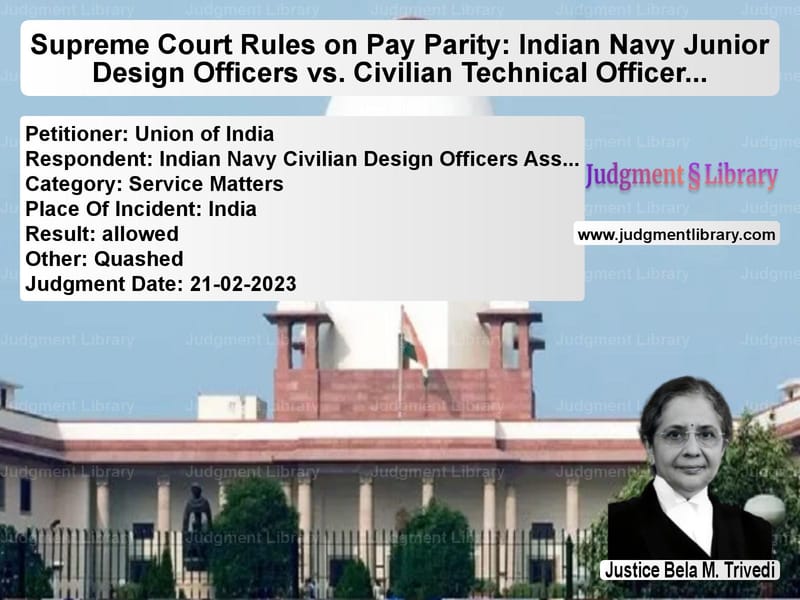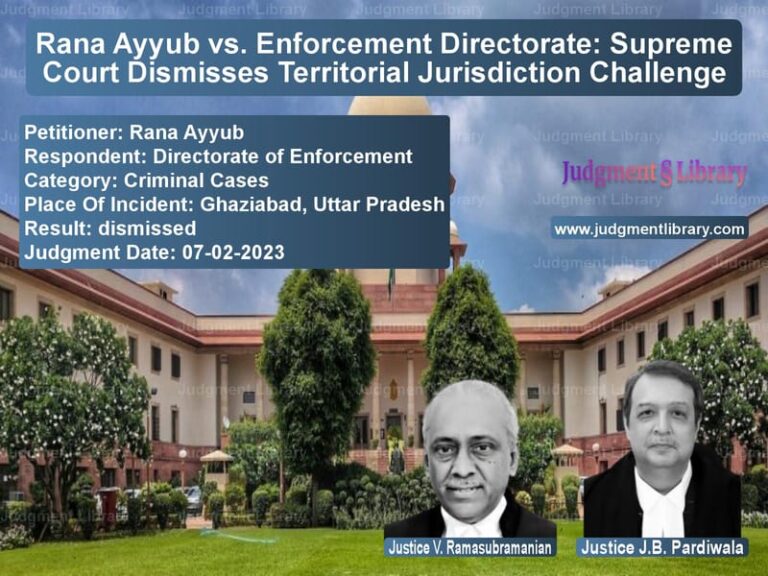Supreme Court Rules on Pay Parity: Indian Navy Junior Design Officers vs. Civilian Technical Officers
The Supreme Court of India, in the case of Union of India vs. Indian Navy Civilian Design Officers Association & Another, ruled on the issue of pay parity between Junior Design Officers (JDOs) and Civilian Technical Officers (CTOs) (Design) in the Indian Navy. The Court overturned the Delhi High Court’s decision that had upheld the Central Administrative Tribunal’s (CAT) ruling granting higher pay scales to JDOs. The Supreme Court reaffirmed that the determination of pay scales falls under the executive’s domain and should not be interfered with unless clear arbitrariness is demonstrated.
Background of the Case
The Indian Navy created the Design Officers cadre in 1965 to meet its technical requirements in naval dockyards, training establishments, and directorates. The drawing staff was divided into various disciplines such as Construction, Electrical, Engineering, and Armament. The gazetted Group ‘B’ posts in Construction, Electrical, and Engineering disciplines were designated as Junior Design Officers (JDOs), while in the Armament discipline, the equivalent posts were Civilian Technical Officers (CTOs) (Design).
Until the implementation of the Fifth Central Pay Commission, both JDOs and CTOs had the same pay scales. However, after the Commission’s recommendations, the pay scale of CTOs was revised to Rs. 7500-12000, while JDOs were placed in a lower scale of Rs. 7450-11500. The JDOs challenged this classification, arguing that both cadres performed the same duties and should receive equal pay.
Their representations for parity in pay scales were rejected by the Ministry of Finance. They then approached the CAT, which ruled in their favor. The Union of India challenged this decision in the Delhi High Court, which upheld the CAT’s order. Aggrieved by this, the Union of India appealed to the Supreme Court.
Arguments by the Appellants (Union of India)
- The government argued that the posts of JDOs and CTOs were governed by different sets of recruitment rules, with CTOs having higher qualifications and longer probation periods.
- It contended that the duties and responsibilities of CTOs were more varied, complex, and demanding compared to JDOs.
- The government cited that CTOs also existed in other organizations such as the R&D sector and had to be given a higher pay scale to maintain consistency.
- Since the Fifth Central Pay Commission specifically recommended different pay scales for these posts, judicial intervention in pay determination was unwarranted.
Arguments by the Respondents (Indian Navy Civilian Design Officers Association)
- The respondents contended that JDOs and CTOs had the same pay scales up to the Fourth Central Pay Commission and that their duties remained identical.
- They argued that JDOs supervised Senior Foremen, who were granted the Rs. 7450-11500 scale, creating an anomaly where supervisors were placed on the same pay scale as subordinates.
- The association pointed out that even within the Navy, internal recommendations had been made to upgrade the pay scale of JDOs.
- The Recruitment Rules and promotional structures for both posts were largely similar, justifying parity in pay scales.
Supreme Court’s Analysis and Judgment
The Supreme Court reviewed the legal principles governing pay determination and judicial intervention. The key findings were:
- Expert Bodies’ Role in Pay Determination: The Court reiterated that the fixation of pay scales is a complex task best left to expert bodies like the Pay Commission. Courts should not interfere unless there is demonstrable arbitrariness.
- Different Recruitment Rules Justify Different Pay: The Court noted that JDOs and CTOs were recruited under different rules and had different entry qualifications and responsibilities.
- No Fundamental Right to Equal Pay: The principle of ‘equal pay for equal work’ is not an absolute right but must be assessed based on multiple factors such as qualifications, job responsibilities, and career progression.
- Judicial Restraint in Pay Fixation: The Court observed that the CAT and High Court overstepped their jurisdiction by interfering in matters of executive discretion concerning pay scales.
The Supreme Court ruled:
“The equation of posts and determination of pay scales is the primary function of the Executive and not the Judiciary. Courts should not enter upon the task of job evaluation, which is best left to expert bodies like the Pay Commissions.”
Final Verdict
- The Supreme Court set aside the Delhi High Court and CAT’s decisions.
- It ruled that JDOs were not entitled to pay parity with CTOs.
- The judgment reinforced the principle that courts should not interfere in executive decisions regarding pay scales unless there is manifest arbitrariness.
This ruling provides a significant precedent in cases involving pay scale disputes, reaffirming that judicial review in such matters should be limited to correcting clear errors rather than re-evaluating technical pay structure decisions.
Petitioner Name: Union of India.Respondent Name: Indian Navy Civilian Design Officers Association & Another.Judgment By: Justice Bela M. Trivedi.Place Of Incident: India.Judgment Date: 21-02-2023.
Don’t miss out on the full details! Download the complete judgment in PDF format below and gain valuable insights instantly!
Download Judgment: union-of-india-vs-indian-navy-civilian-supreme-court-of-india-judgment-dated-21-02-2023.pdf
Directly Download Judgment: Directly download this Judgment
See all petitions in Pension and Gratuity
See all petitions in Public Sector Employees
See all petitions in Judgment by Bela M. Trivedi
See all petitions in allowed
See all petitions in Quashed
See all petitions in supreme court of India judgments February 2023
See all petitions in 2023 judgments
See all posts in Service Matters Category
See all allowed petitions in Service Matters Category
See all Dismissed petitions in Service Matters Category
See all partially allowed petitions in Service Matters Category







